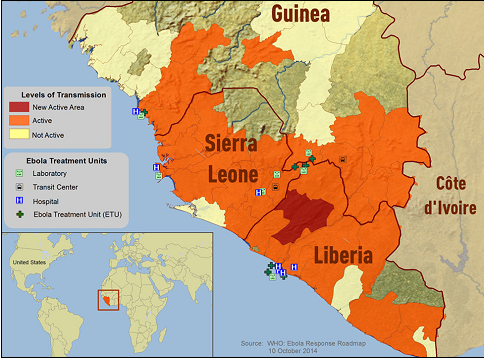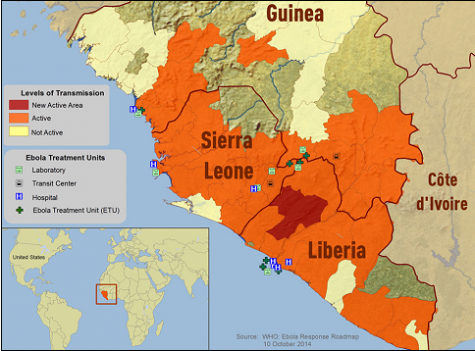Ebola: symptoms, stats, safety
October 25, 2014
The 2014 Ebola virus disease (EVD) epidemic has been reported in seven countries since its outbreak.
The virus has reportedly infected 8,399 individuals and killed more than 4,500, according to a recent update from the World Health Organization (WHO).
The virus has now been identified in Guinea, Liberia, Senegal, Sierra Leone and the United States.
Celia Johnson, a registered nurse with Central’s Student Health, Counseling & Wellness Center, said that there have been no reports of EVD in the Pacific Northwest.
As reported by CNN, WHO recently announced to news outlets that if the EVD epidemic isn’t contained, it could reach anywhere from 5,000 to 10,000 new cases per week by the end of 2014.
Central biology professor Holly Pinkart’s research focuses on microecology, looking at bacteria and viruses and their interactions with each other and the environment.
Pinkart will be giving a talk about EVD this Friday. She said that while EVD replicates similarly to the influenza virus, it can infect a wider range of cells.
“All viruses need to bind to a receptor on a cell, and then that triggers their update,” Pinkart said. “The receptors that EVD uses are present on lots of different cells, and it appears that they actually have two different entry strategies.”
The American Center for Disease Control and Prevention (CDC) has reported that three cases have been confirmed in the United States.
The first patient with EVD to be confirmed in the United States was diagnosed on Sept. 30 and died on Oct. 8.
According to a recent CDC press release, the patient traveled by air from Liberia the day before he first reported symptoms.
The CDC website says that it will begin enhanced screening for entry at five U.S. airports which receive travelers from the affected West African countries.
Although EVD is contagious through direct contact with body fluids, it is easily isolated. Johnson also said that the viral load is a big determinant in how contagious a person may be.
“Ebola is a scary thing,” Johnson said. “But it is relatively hard to get.”
According to the CDC, people infected with EVD are only contagious once they begin to show symptoms. The CDC also says that the virus is not likely to be transmitted through dogs or cats.
Pinkart said that in experiments in which Ebola particles were introduced to a pig through its eye, it was determined that 400,000 particles were required for the virus to successfully infect the animal. She said that this is known as the minimal infectious dose.
Pinkart said that pre-existing factors in West African countries should be considered when comparing outbreaks there to cases in the United States. She said that such factors set the stage for an infectious disease which is difficult to control.
“To put it in context for that region, before the outbreak, Guinea had the fewest number of [hospital] beds per capita in the world,” Pinkart said. “Liberia had one doctor for every 71,000 people. And Sierra Leone had the lowest life expectancy, globally.”
When people in those countries would go to the doctor showing signs of EVD, they would be sent back home. This in turn allowed the virus to spread, Pinkart said.
Recently, a study by Charles N. Haas suggests that a 21-day observation for suspected EVD patients may not be sufficient.
Haas wrote in the conclusion of the study that the current 21-day observation period was based on reasonable interpretations of data from early outbreaks.
“In previous outbreaks, the rate of infection, or R0, was calculated at the end of the outbreak to be 1.8,” Pinkart said.
The R0 for the current outbreak may be different, according to Pinkart.
“You had people that were taking a lot of precautions,” Pinkart said. “You had one infected person that infected at least two other nurses, and that was with a fair amount of protection.”
This increased rate of infection may be due to either a mutation of the virus, or the simple fact that this EVD may be a different strain than the previous outbreaks.
“The R0 may be a little bit higher for this strain,” Pinkart said.
It is not known if humans can be carriers for the virus, Pinkart said. After a 1995 outbreak, scientists began searching for organisms that may act as natural reservoirs for the disease.
Although everything from insects to plants were tested, Pinkart said that ultimately only fruit bats were determined to be able to safely host the virus.
Pinkart said that it is unknown whether humans may act as a carrier for the virus, but did say that it was unlikely due to the nature of the disease and the human body’s immune response.
Although accidents have occurred, authorities have a very good handle on containing the disease. Senegal, which recently reported a case, just announced itself EVD-free.
Johnson said that the best way to combat EVD is through public education and an understanding about the situation.
“You want people to be knowledgeable, always,” Johnson said. “But [you] want them to have the correct information so they can make good choices.”
According to the CDC, Pinkart and Johnson, there is little to no chance of catching EVD in the United States.
“Even with the breaches in protocol, there is a very, very, very small risk of a problem,” Pinkart said. “Although breaches happen, we do know how to contain this.”
According to the WHO, Nigeria has been declared EVD-free after 42 consecutive days without detected cases.
Infections by country
United States – 3
Liberia – 4,249
Sierra Leone – 1,352
Guinea – 1,472
Center for Disease Control; Oct. 18, 2014
Confirmed deaths
United States – 1
Liberia – 2,458
Sierra Leone – 1,183
Guinea – 843
Center for Disease Control; Oct. 18, 2014
Symptoms of Ebola
Fever
Severe headache
Muscle pain
Weakness
Diarrhea
Vomiting
Abdominal pain
Unexplained hemorrhage
Source: Center for Disease Control



